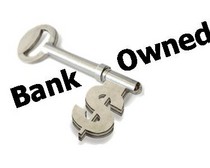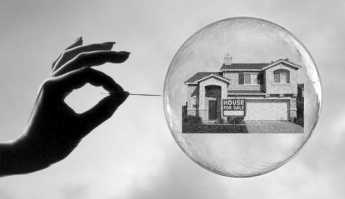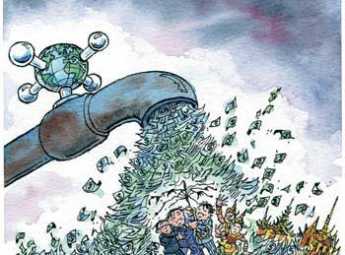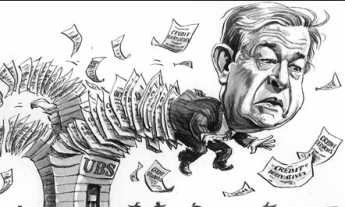Related Topics
Banking Panic 2007-2009 (1)
Mankind hasn't learned how to control sudden wealth, whether in families, third-world countries, or the richest nation in history. The world banking crisis of 2007 is the biggest example yet.
Banking

|
| Bank Owned |
In such circumstances, banks could be expected to start holding back. But no, there was too much even cheaper money available for banks to borrow, leverage up with more borrowing, and re-lend to homeowners. It got to the point where a dollar of the bank's own money supported thirty dollars of loans to customers, and homeowners still lined up for more. The solution to the conundrum was suddenly clear: too much cheap money was in circulation, and it was coming from China and the Middle East. Because the prices of houses were going up steadily, banks took a chance on the plain fact that thirty-to-one announces that a loss of house value of 3% means the mortgage is losing money. A couple of other ugly facts are somewhat less obvious: when interest rates go up, the value of the loan goes down. Secondly, when banks reduce their thirty-to-one borrowing to a safer twenty-to-one, the de-leveraging raises interest rates still more, lowering home values still more. A downward spiral can easily get started. Historically, banks were protected by the homeowner's down payment; down payments had become minimal. Adjustable rate mortgages were now popular, a process of shifting the risk of interest fluctuations from the bank to the homeowner, as the homeowner would soon learn if interest rates rose.
 We faced a big problem caused by too much cheap money, and we struggled to save the situation -- by injecting more cheap money.
We faced a big problem caused by too much cheap money, and we struggled to save the situation -- by injecting more cheap money.

|
Time passed, abnormally low-interest rates had persisted after Greenspan's public mutterings. The weak point was the home mortgage, exactly where risky loans are artificially encouraged by implied congressional protection. Reluctant to see foreclosures, politicians stood ready to command mortgages to walk on water. Although it was pretty evident that lending standards were lax, the differing degrees of risk were not reflected in the "risk premium" or width of the "spreads." That is, bond investors remained mysteriously content to be paid interest rates scarcely greater for risky investments than for safe ones such as U.S. Treasury bonds. The markets viewed those two as essentially equivalent. Since these interest rates and the risk evaluation they reflect are set by supply and demand in the credit markets, the persisting anomaly of low rates had to be traceable to either excessive cheap money, or investor overconfidence. In retrospect, it was both. Foreign money flowed in from Far East prosperity and Persian Gulf oil profits. Whether it pushed in or was sucked in, remains a matter of opinion. Wall Street greeted this bonanza with "securitization" -- new lending mechanisms for home mortgages--and builders went into high gear building more houses, especially in California and Florida. They built too many because it's hard to walk away when business is brisk. Because of distorted tax structures, mortgages were the preferred means of borrowing for any private person. Eventually, the bubble burst; it remains to be seen whether we would now go on to some other bubble (commodities, for example) or sink into a protracted depression. If it's to be depression, a new uncertainty arises. When investors accepted low rates in the expectation that politicians would bail out bad mortgages, they surely predicted rightly. The real risk is, it won't do any good.

|
| Alan Greenspan |
As Greenspan was implying, prosperity usually puts upward pressure on interest rates but this time it remained a coiled spring; house prices made unprecedented rises for several years in a row but mortgages remained cheap. In mid-August 2007, bank turmoil in a couple of European banks suddenly prompted a rise in worldwide long term interest rates, more or less obscured by a lurching drop in the stock market. It seems likely this unexpected stock movement created misleading signals; in a day or two stock prices recovered. It was mortgage interest rates snapping back toward normal levels that truly mattered because that predicted excessive home prices would now surely decline; even worse, house plus mortgage might soon cost more than overstretched consumers could afford, provoking panic selling of houses. In any case, house prices could be expected to fall until it was no longer cheaper to rent than to buy, and it was then an open question of whether rents might also be chased down further. Patterns were hard to identify at first; different parts of the country overbuilt to different degrees. Even worse spirals could be imagined, too. If a house must be sold for less than the unpaid mortgage, a homeowner is tempted to surrender the mortgage and walk away, so foreclosures might be more common than economic conditions alone would warrant. If homebuilding stops because of a housing glut, immigrant laborers may -- or may not -- go back home, after first looking around to see if patches of the country are still building houses. A recession may spread, the national election in November may turn our unexpectedly; all sorts of things might -- or might not -- happen.
Banks had been the most strained by all the good fortune of cheap foreign credit because they make their profit on the "yield curve" -- the difference between what they pay for deposits and what they charge for loans. For over a year, the yield curve had been inverted, meaning banks were often close to paying depositors more than they got back from borrowers. Dropping interest rates paid to depositors would increase bank profits, but go too far with that and depositors will be chased away to money market funds, or treasury bills. The problems of banks became the problem of the Federal Reserve. The Fed controls short-term lending costs but generally lets the bond markets establish long term rates. With long rates abnormally low for a long time, banks were severely tested to make a profit, which for them essentially consists of paying depositors low short term rates, and lending debtors the money at high long term rates. A very narrow spread between short and long rates deprived banks of their means of support. This "flattening of the yield curve" became threatening to banks and also to the Federal Reserve, whose whole system of controlling the money supply was based on their control over banks. Subsequent to the crash, a number of commentators led by the Cato Institute have severely criticized the Federal Reserve for maintaining low short-term interest rates for too long, and others have even attributed a motive of supporting the Bush administration by inflating the currency. It is unnecessary to place this construction on the Fed's behavior. If the banks depend for survival on the difference between long and short rates, and if the Fed is powerless to raise long rates, there is nothing to do but lower short rates. This has the unintended effect of stimulating inflation, and Greenspan has later admitted he regrets it. But he seems willing to accept the implication that he was dabbling in politics, rather than admit to what is more likely to have been the cause of this behavior. The whole theory of how the Federal Reserve currently combats inflation is based on "inflation targeting", in which the central bank essentially ignores every other signal and responds to its measurements of inflation in the economy. These measurements were also distorted by the flood of Chinese money, so the very force which was causing inflation was also making it appear that inflation was not a big concern. Since the value of money in current times is almost entirely a decision of the central banks, it seems too central bankers that public trust in that process must be preserved at all costs. And, indeed, when the behavior of Congress is observed on C-span television there can be a reason to be quite sympathetic with the plight of our monetary policy leaders. There remains however little doubt that the formulas for detecting inflation require some modification for changing circumstances.
So to go back a few years to the time when the bubble in housing prices was getting started -- banks had resorted to some new and therefore risky procedures that seemed to side-step their difficult situation. With borrowers flocking in the door, banks were able to sell the loans of constantly rising size to the secondary market as fast as fresh borrowers came in. To understand this inflammatory issue, it is probably necessary to go back to the depression of the 1930s. At another time of confused floundering in the financial markets, public opinion centered on splitting up the functions of big banks for easier control by government regulators. Commercial banks, who obtain their lendable funds by accepting deposits, were forbidden to be incorporated with investment banks, who obtain their lendable funds by selling bonds. And incentives or regulations were modified to direct home mortgages to savings and loan banks. Forty years later, the Arab oil embargo precipitated a monetary situation where interest rates rose to nearly 20%. Savings and loan banks, holding enormous amounts of thirty-year mortgages at roughly 6%, had to close their doors because they could not remain, viable paying depositors, such rates. Thousands of savings and loans, holding nearly 50% of the home mortgages in America, went out of business. A vacuum was thus created, and some other mechanism for financing mortgages was extremely welcome. With almost inhuman ingenuity and innovation, Wall Street invented the CDO and marketed hundreds of billions of dollars worth.
It had elements of a Ponzi scheme but perhaps it was controllable. The banks who merely originated loans did create an undeniable moral hazard because they naturally took less precaution with loans they were immediately going to sell to someone else. No one, it is said, bothers to wash a rental car. Meanwhile, the strain of an inverted yield curve began to take its toll on the banks; after a year of it, their reserves started to get depleted.
Whether banks pushed or were pulled is debatable. Probably the bigger part of the growing problem was created by those ingenious investment banks on Wall Street, who were buying these increasingly risky mortgages and loans by the truckload. Bundling up thousands of mortgages into a new creature called collateralized debt obligations (CDO), they sold them to the public as "securitized debt". In effect, debt was partially converted to equity -- little bonds into big bonds, but the riskiest little bonds sifted out and converted into equity. It was a remarkably imaginative revolution in finance, but even if every step was absolutely perfect there could always be a danger that the generation of many $trillions worth of new paper would topple existing arrangements by simply going too fast for other systems to adjust. That's what happened, although there were inevitably also some design imperfections that got ignored for too long.

|
| housing bubble burst |
So the financial world started to crash in the middle of August 2007, while the rest of us were enjoying a summer vacation. The housing bubble burst; the party was suddenly over. The television was filled with scenes of traders jumping up and down, screaming orders to each other. Commentators commented excitedly every five minutes, and pundits screamed that the Federal Reserve must do something. All of this communications uproar conveyed the impression that a final explosion of some sort had taken place, and we could, therefore, expect a long period of post-bomb silence. But that really was not what seemed to happen. The stock markets dipped but recovered. House prices were down a little, in some places. Gas and oil prices remained too high and went a little higher. The Federal Reserve dropped short-term interest rates a few fractions of a percent, long term rates scarcely moved at all. In the background, America was fighting two overseas wars and a presidential primary campaign, but somehow they weren't part of the equation. Rather, it was explained that the consequences of August would be delayed, taking many months to unwind. A crash, in other words, in slow motion.
That might be so. It often takes months to buy and sell houses; their value may have declined, but a thing is worth what you can sell it for, so you can't be sure what they are worth until houses are actually sold. Essentially the same thing is true of stocks and bonds, and it's hard to know if securities are worth the amount of the comparable most recent sale. or if you should measure them against what you suppose will be the price when you sell later. Auditors and bank regulators are rigid about their answer: banks must "mark to market" if they intend to base future loans on the securities in their vaults. The rest of us would rather wait and see and must do so for tax purposes. You can scarcely blame bankers for hoping the turmoil creates a V-shaped dip that can safely be ignored. Even if it does not, a protracted economic pause can create time to patch things up, generate new sources of income to replace what is lost, if it is lost. Only the gold market seemed to disregard such assurances, gold was emphatically on the rise. After six months of relative calm, it was still possible to believe this was a passing flurry, or to believe we were floating downstream to a tumble over another waterfall. America in the 1930s and Japan in the 1990s had discovered that drift and uncertainty can sometimes last fifteen years. After a brief recital of the events leading up to August, we next embark on a more detailed (but simplified) discussion of what went on, eventually leading to conjectures about what comes next, particularly what the Federal Reserve can and should do about it.

|
| Market Flooding |
Spreads, as bankers say, widen and narrow. Last August, the risk-premium demanded risky lending was stubbornly lower than history suggested was normal. In fact, the prevailing interest rate for mortgages and other long term loans was lower than interest-bearing cash in the form of money market funds was paying, a rather uncommon situation called inverted yield, or an inverted yield curve if you draw a picture of it. Stubbornly low long-term interest rates became a particular concern for the Federal Reserve and the commercial banks it regulates because the spread between long rates and short ones was not only where banks made a profit but how the Fed regulates the money supply. Since now the only way to maintain a profitable differential was for the Federal Reserve to lower short-term rates, it forced the Fed to hurt retirees and be inflationary by flooding the market with cheap short-term reserves. To put it another way, a flood of Chinese or Arab money into long-term bonds could only be kept in balance by a matching American flood into short-term ones. Inflation was already beginning to worry the Fed, so this development was unwelcome. At the extreme, it might force a choice between promoting inflation -- and bankrupting the banks. Add to this the conjecture that old-fashioned banking was eventually destined to vanish anyway, into some bright new computerized efficiency devised by Wall Street wizards; and you have to wonder if the very worst consequence might be to prevent creative destruction from taking place. It's awesome how simple changes multiply into a turmoil you can hardly understand.

|
| Quantitative traders |
On August 17, that risk premium squeeze went away. Long term rates for risky bonds went up, but safe bonds like U.S. Treasuries stayed about the same. While it is always a relief to see things return to normal, the gruesome fact is that money, or at least value, had to be destroyed to accomplish it. The nature of the secondary bond market is that a rise in the interest rate causes a corresponding drop in the price of bonds, a loss which will only be restored by increased interest over a long subsequent period of years, possibly not until the bond reaches maturity. That means for a long time more money is lost on bond principal than is gained on bond interest. An incentive to sell everything else is thus created for the bondholder, creating a contagion of selling. To return to Mr. Greenspan's conundrum, a suppressed interest rate had been creating an illusion of wealth whose disappearance was now reluctantly acknowledged. Some bondholders tried to dump before the full effect was felt, others held back from selling but eventually had to liquidate something to raise working capital. Panic selling spread, and unanimous fear of the unexpected caused "congested" trading, all in a downward direction. The Federal Reserve first helped out by dropping the interbank discount rate (the rate one bank charges another when one of them finds it needs to borrow to keep its books in balance) the next morning, but that action carried further messages of panic. Quantitative traders ("Quants") who programmed their computers to sell on signals of trouble were misled by huge sell activity which actually avoided the long bonds at the root of the problem, primarily because no one would buy them. Astonishing quantities of sell orders of perfectly good securities were accordingly issued by the obedient computing machines. Nobody knew what was going on, but everyone suspected something had been funny about bond rates for two years. Those who did not sell were ready to sell, and would certainly not buy. All markets were congested; credit markets were soon frozen solid. Someone was going to go bankrupt, but there was no time to find out who it was. Without transparency, markets will not clear.

|
| Credit derivatives |
Clarifications eventually surfaced in jumbled sequence. The main difficulty was concentrated in those new mechanisms for financing home mortgages, "derivatives" for which unfamiliar abbreviations leaped into excited jargon. Subprime loans, better called unwise loans were sold to victims, or maybe abused by speculators. "Credit derivatives" based on mortgages and other assets were discussed knowingly by those who a year earlier had never heard of them. The huge size of these mysterious instruments merits emphasis. There had been $26 trillion worth of credit derivatives in existence six months earlier, some said it was now $42 trillion. (A year later it was to be $62 trillion.) Compared with that, the entire mortgage debt of the country was said to be only $9 trillion, and the entire U.S. equity market was something like $13 trillion. Even congressional investigating committees were afraid to say much about something that big, that new, and that obscure.
Most confusing of all was to compare the growing consensus about the underlying difficulty with the solution now demanded by Wall Street, and apparently accepted by the Federal Reserve, our President, and our Congress. We started out with a problem created by foreign money flooding into our mortgage market; that's more or less comprehensible. The Fed then lowered short-term interest rates, Congress produced fiscal stimulus; both of these things created cheaper money, more credit and a lower international value for the dollar. The centerpiece of the solution was to create still more cheap credit, both at the Federal Reserve and with a Congressional Stimulus Package, when the problem was we already had too much cheap money.
Please, sirs. Would you mind saying that again, slowly?
Originally published: Friday, April 17, 2009; most-recently modified: Tuesday, May 14, 2019